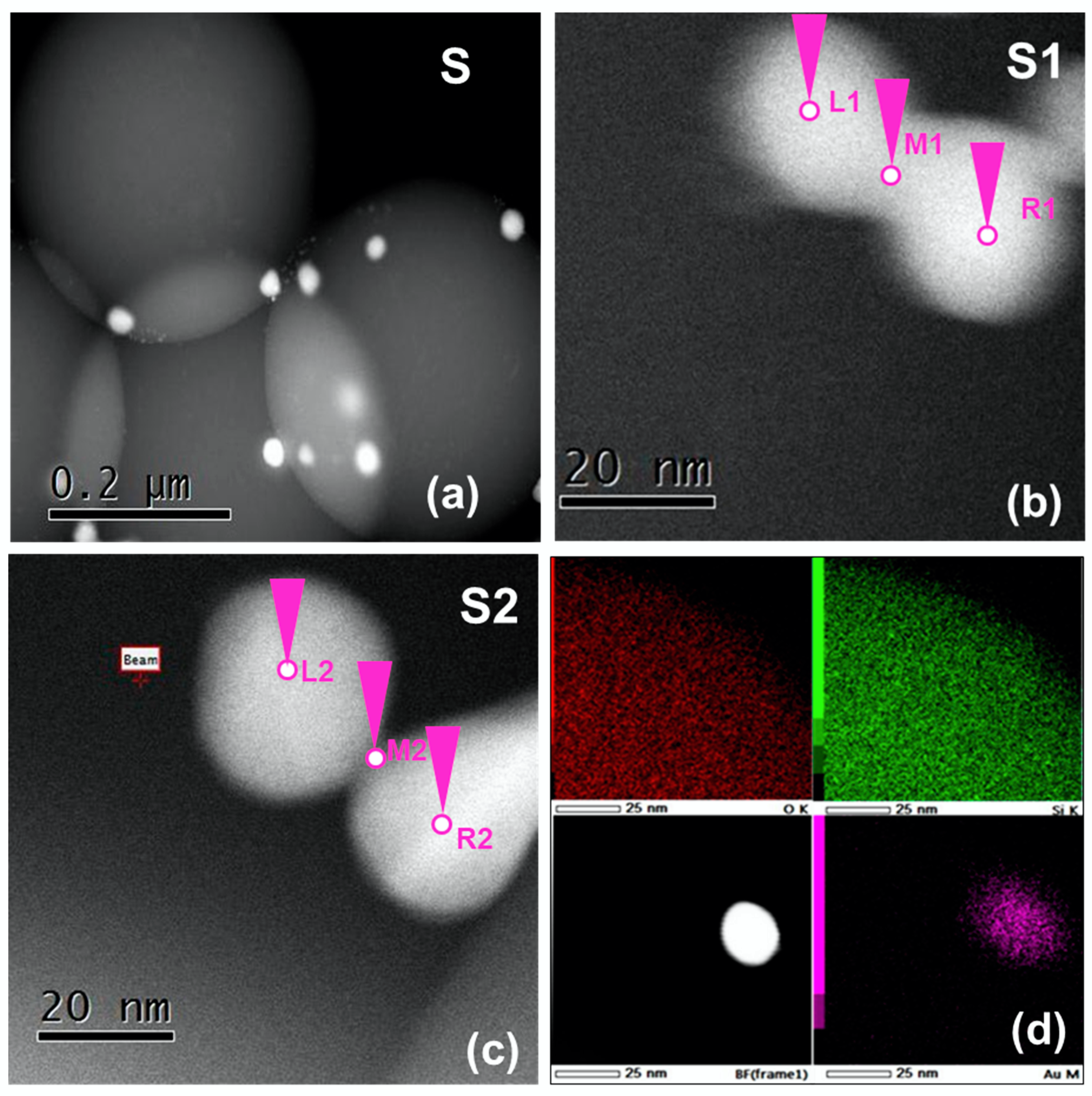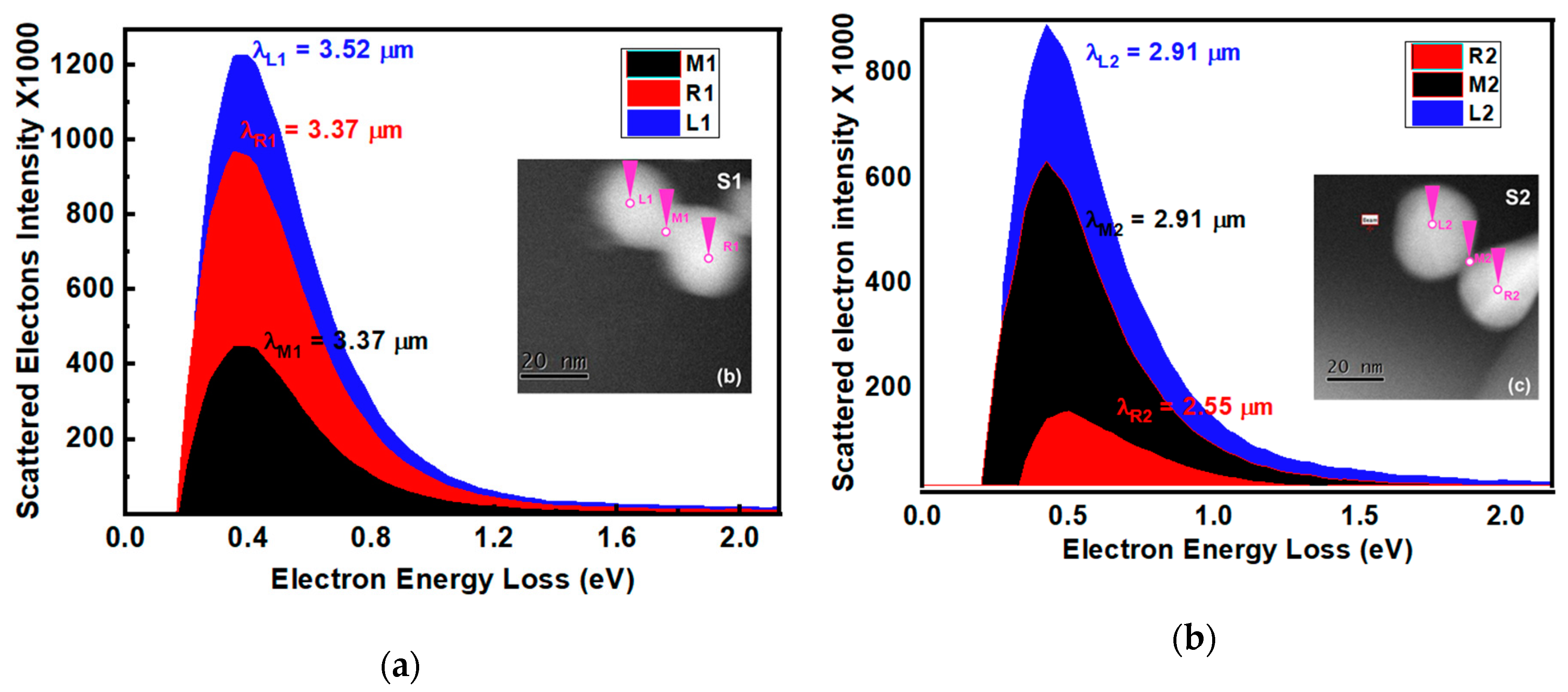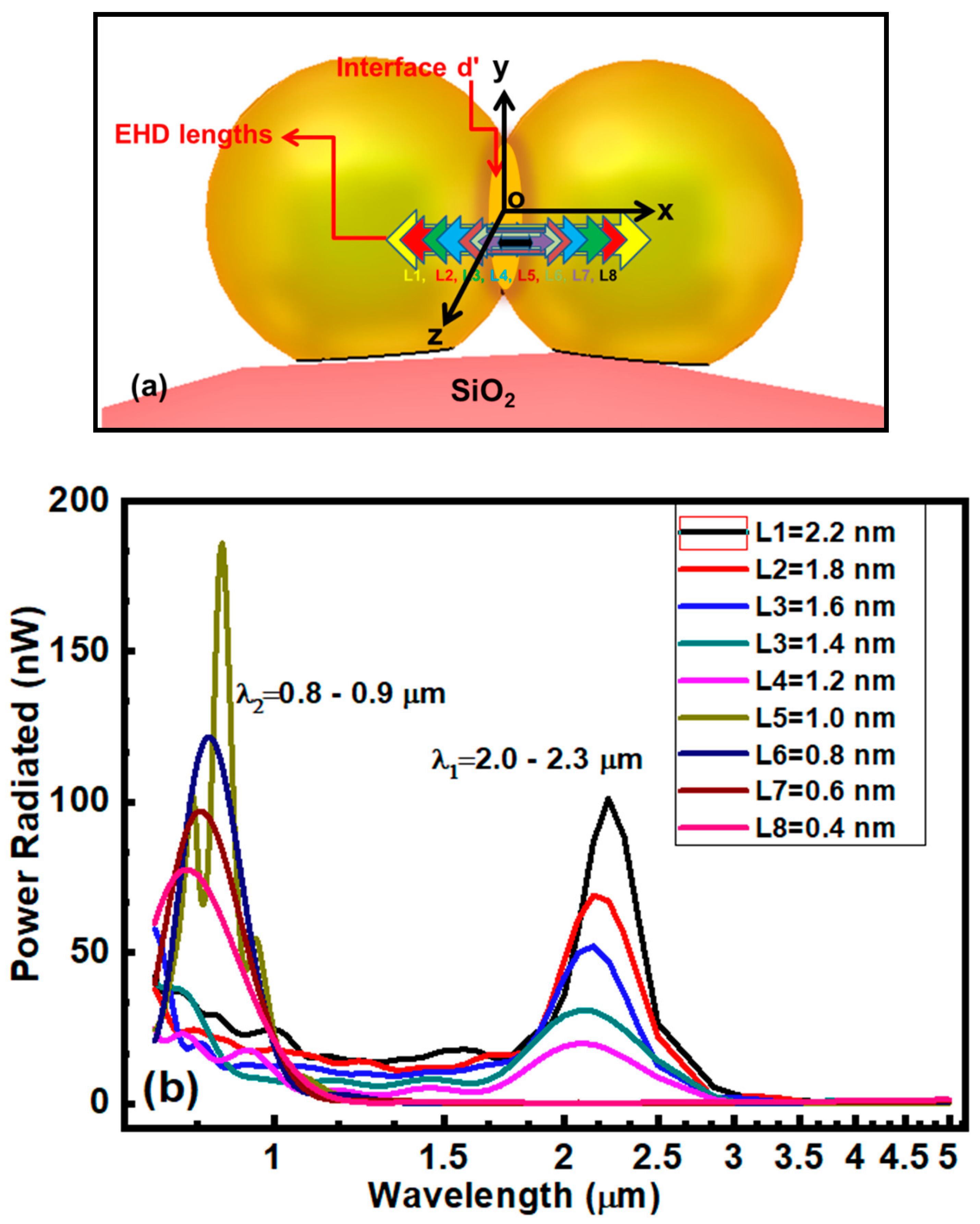Interface-Induced Near-Infrared Response of Gold-Silica Hybrid Nanoparticles Antennas
Abstract
1. Introduction
2. Material and Methods
2.1. Synthesis of Nanoparticles
2.2. EELS Experiment
3. Result and Discussion
3.1. EELS Experiment
3.2. Numerical Analysis and Modelling
4. Conclusion
Supplementary Materials
Author Contributions
Funding
Conflicts of Interest
References
- Schuller, J.A.; Barnard, E.S.; Cai, W.; Jun, Y.C.; White, J.S.; Brongersma, M.L. Plasmonics for extreme light concentration and manipulation. Nat. Mater. 2010, 9, 193–204. [Google Scholar] [CrossRef]
- Schmidt, F.P.; Ditlbacher, H.; Hohenester, U.; Hohenau, A.; Hofer, F.; Krenn, J.R. Dark Plasmonic Breathing Modes in Silver Nanodisks. Nano Lett. 2012, 12, 5780–5783. [Google Scholar] [CrossRef]
- Gordon, J.A.; Ziolkowski, R.W. Investigating functionalized active coated nanoparticles for use in nano-sensing applications. Opt. Express 2007, 15, 12562–12582. [Google Scholar] [CrossRef]
- Gopinath, A.; Boriskina, S.V.; Reinhard, B.M.; Negro, L.D. Deterministic aperiodic arrays of metal nanoparticles for surface-enhanced Raman scattering (SERS). Opt. Express 2009, 17, 3741–3753. [Google Scholar] [CrossRef]
- Nie, S.; Emory, S.R. Probing Single Molecules and Single Nanoparticles by Surface-Enhanced Raman Scattering. Science 1997, 275, 1102–1106. [Google Scholar] [CrossRef]
- Chu, M.-W.; Myroshnychenko, V.; Chen, C.H.; Deng, J.-P.; Mou, C.-Y.; De Abajo, F.J.G. Probing Bright and Dark Surface-Plasmon Modes in Individual and Coupled Noble Metal Nanoparticles Using an Electron Beam. Nano Lett. 2009, 9, 399–404. [Google Scholar] [CrossRef] [PubMed]
- Rossouw, D.; Couillard, M.; Vickery, J.; Kumacheva, E.; Botton, G. Multipolar Plasmonic Resonances in Silver Nanowire Antennas Imaged with a Subnanometer Electron Probe. Nano Lett. 2011, 11, 1499–1504. [Google Scholar] [CrossRef] [PubMed]
- Dong, L.; Yang, X.; Zhang, C.; Cerjan, B.; Zhou, L.; Tseng, M.L.; Zhang, Y.; Alabastri, A.; Nordlander, P.; Halas, N.J. Nanogapped Au Antennas for Ultrasensitive Surface-Enhanced Infrared Absorption Spectroscopy. Nano Lett. 2017, 17, 5768–5774. [Google Scholar] [CrossRef] [PubMed]
- Chae, J.; Lahiri, B.; Centrone, A. Engineering Near-Field SEIRA Enhancements in Plasmonic Resonators. ACS Photon. 2015, 3, 87–95. [Google Scholar] [CrossRef]
- Brown, L.V.; Yang, X.; Zhao, K.; Zheng, B.Y.; Nordlander, P.; Halas, N.J. Fan-Shaped Gold Nanoantennas above Reflective Substrates for Surface-Enhanced Infrared Absorption (SEIRA). Nano Lett. 2015, 15, 1272–1280. [Google Scholar] [CrossRef]
- Yan, C.; Yang, K.-Y.; Martin, O.J. Fano-resonance-assisted metasurface for color routing. Light. Sci. Appl. 2017, 6, e17017. [Google Scholar] [CrossRef] [PubMed]
- Kim, J.; Han, K.; Hahn, J.W. Selective dual-band metamaterial perfect absorber for infrared stealth technology. Sci. Rep. 2017, 7, 6740. [Google Scholar] [CrossRef] [PubMed]
- Lee, D.; Han, S.Y.; Jeong, Y.; Nguyen, D.M.; Yoon, G.; Mun, J.; Chae, J.; Lee, J.H.; Ok, J.G.; Jung, G.Y.; et al. Polarization-sensitive tunable absorber in visible and near-infrared regimes. Sci. Rep. 2018, 8, 12393. [Google Scholar] [CrossRef] [PubMed]
- Boriskina, S.V.; Weinstein, L.A.; Tong, J.K.; Hsu, W.-C.; Chen, G. Hybrid Optical–Thermal Antennas for Enhanced Light Focusing and Local Temperature Control. ACS Photon. 2016, 3, 1714–1722. [Google Scholar] [CrossRef]
- Neubrech, F.; Pucci, A. Plasmonic Enhancement of Vibrational Excitations in the Infrared. IEEE J. Sel. Top. Quantum Electron. 2012, 19, 4600809. [Google Scholar] [CrossRef]
- Haberfehlner, G.; Trügler, A.; Schmidt, F.P.; Hörl, A.; Hofer, F.; Hohenester, U.; Kothleitner, G. Correlated 3D Nanoscale Mapping and Simulation of Coupled Plasmonic Nanoparticles. Nano Lett. 2015, 15, 7726–7730. [Google Scholar] [CrossRef] [PubMed]
- Kim, J.-H.; Bryan, W.W.; Lee, T.R. Preparation, Characterization, and Optical Properties of Gold, Silver, and Gold−Silver Alloy Nanoshells Having Silica Cores. Langmuir 2008, 24, 11147–11152. [Google Scholar] [CrossRef]
- Guillaume, S.-O.; De Abajo, F.J.G.; Henrard, L. Efficient modal-expansion discrete-dipole approximation: Application to the simulation of optical extinction and electron energy-loss spectroscopies. Phys. Rev. B 2013, 88, 245439. [Google Scholar] [CrossRef]
- Oskooi, A.F.; Roundy, D.; Ibanescu, M.; Bermel, P.; Joannopoulos, J.; Johnson, S.G. Meep: A flexible free-software package for electromagnetic simulations by the FDTD method. Comput. Phys. Commun. 2010, 181, 687–702. [Google Scholar] [CrossRef]
- Hohenester, U. Simulating electron energy loss spectroscopy with the MNPBEM toolbox. Comput. Phys. Commun. 2014, 185, 1177–1187. [Google Scholar] [CrossRef]
- Geng, J.; Ziolkowski, R.W.; Jin, R.; Liang, X. Numerical Study of the Near-Field and Far-Field Properties of Active Open Cylindrical Coated Nanoparticle Antennas. IEEE Photon. J. 2011, 3, 1093–1110. [Google Scholar] [CrossRef]
- Rahman, A.U.; Geng, J.; Rehman, S.U.; Hayat, K.; Liang, X.; Jin, R. Gap-Dependent Localized High Energy Multiple Dipolar Modes in Passive Silver-Coated Silica Nanoparticle Antennas. Appl. Sci. 2017, 7, 1183. [Google Scholar] [CrossRef]
- Stöber, W.; Fink, A.; Bohn, E. Controlled growth of monodisperse silica spheres in the micron size range. J. Colloid Interface Sci. 1968, 26, 62–69. [Google Scholar] [CrossRef]
- van Blaaderen, A.; Vrij, A. Synthesis and Characterization of Monodisperse Colloidal Organo-silica Spheres. J. Colloid Interface Sci. 1993, 156, 1–18. [Google Scholar] [CrossRef]
- Westcott, S.L.; Oldenburg, S.J.; Lee, T.R.; Halas, N.J. Formation and Adsorption of Clusters of Gold Nanoparticles onto Functionalized Silica Nanoparticle Surfaces. Langmuir 1998, 14, 5396–5401. [Google Scholar] [CrossRef]
- Bosman, M.; Keast, V.J.; Watanabe, M.; Maaroof, A.I.; Cortie, M.B. Mapping surface plasmons at the nanometre scale with an electron beam. Nanotechnology 2007, 18, 165505. [Google Scholar] [CrossRef]
- de Abajo, F.G. Optical excitations in electron microscopy. Rev. Mod. Phys. 2010, 82, 209–275. [Google Scholar] [CrossRef]
- Egerton, R.F. Electron energy-loss spectroscopy in the TEM. Rep. Prog. Phys. 2008, 72, 16502. [Google Scholar] [CrossRef]
- Guiton, B.S.; Iberi, V.; Li, S.; Leonard, D.N.; Parish, C.M.; Kotula, P.G.; Varela, M.; Schatz, G.C.; Pennycook, S.J.; Camden, J.P. Correlated Optical Measurements and Plasmon Mapping of Silver Nanorods. Nano Lett. 2011, 11, 3482–3488. [Google Scholar] [CrossRef]
- Panaro, S.; Nazir, A.; Liberale, C.; Das, G.; Wang, H.; De Angelis, F.; Zaccaria, R.P.; Di Fabrizio, E.; Toma, A. Dark to Bright Mode Conversion on Dipolar Nanoantennas: A Symmetry-Breaking Approach. ACS Photon. 2014, 1, 310–314. [Google Scholar] [CrossRef]
- Chen, K.; Dao, T.D.; Nagao, T. Tunable Nanoantennas for Surface Enhanced Infrared Absorption Spectroscopy by Colloidal Lithography and Post-Fabrication Etching. Sci. Rep. 2017, 7, 44069. [Google Scholar] [CrossRef] [PubMed]
- Li, G.; Cherqui, C.; Wu, Y.; Rack, P.; Masiello, D.; Camden, J. Characterizing Localized Surface Plasmons using Electron Energy-Loss Spectroscopy. In Proceedings of the 16th European Microscopy Congress, Lyon, France, 28 August–2 September 2016. [Google Scholar]




© 2020 by the authors. Licensee MDPI, Basel, Switzerland. This article is an open access article distributed under the terms and conditions of the Creative Commons Attribution (CC BY) license (http://creativecommons.org/licenses/by/4.0/).
Share and Cite
Rahman, A.U.; Geng, J.; Rehman, S.U.; Iqbal, M.J.; Jin, R. Interface-Induced Near-Infrared Response of Gold-Silica Hybrid Nanoparticles Antennas. Nanomaterials 2020, 10, 1996. https://doi.org/10.3390/nano10101996
Rahman AU, Geng J, Rehman SU, Iqbal MJ, Jin R. Interface-Induced Near-Infrared Response of Gold-Silica Hybrid Nanoparticles Antennas. Nanomaterials. 2020; 10(10):1996. https://doi.org/10.3390/nano10101996
Chicago/Turabian StyleRahman, Atta Ur, Junping Geng, Sami Ur Rehman, Muhammad Javid Iqbal, and Ronghong Jin. 2020. "Interface-Induced Near-Infrared Response of Gold-Silica Hybrid Nanoparticles Antennas" Nanomaterials 10, no. 10: 1996. https://doi.org/10.3390/nano10101996
APA StyleRahman, A. U., Geng, J., Rehman, S. U., Iqbal, M. J., & Jin, R. (2020). Interface-Induced Near-Infrared Response of Gold-Silica Hybrid Nanoparticles Antennas. Nanomaterials, 10(10), 1996. https://doi.org/10.3390/nano10101996





